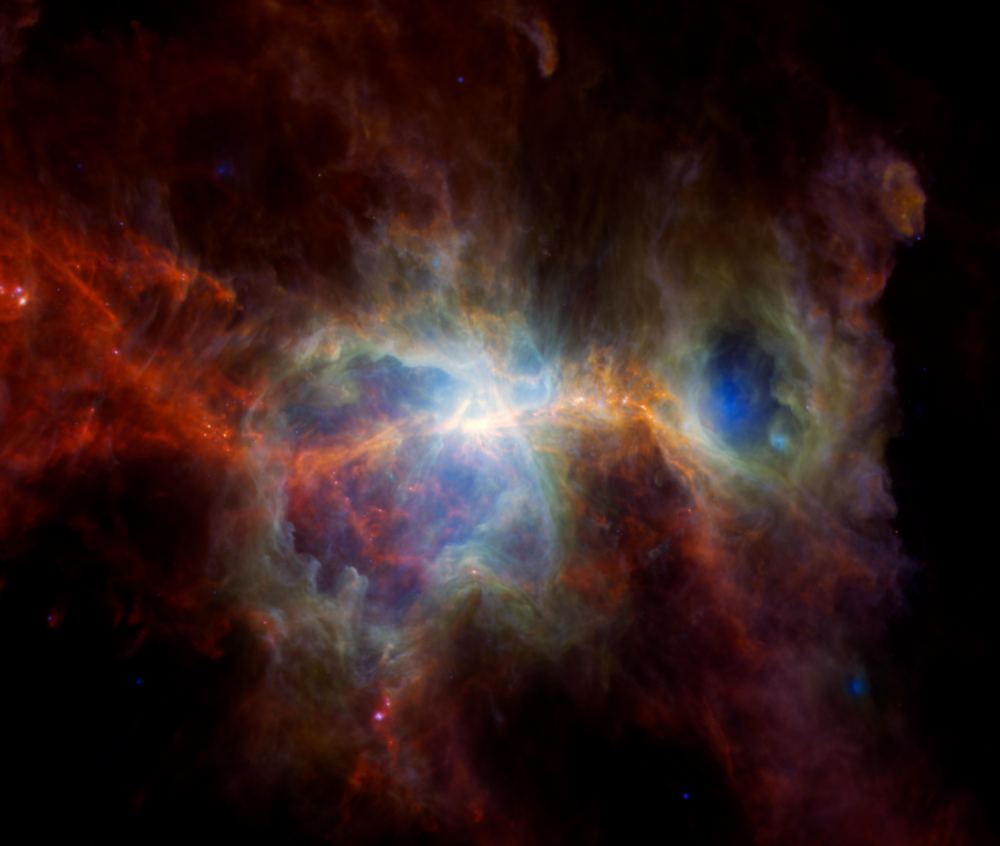Young protostars are wrapped in what could be called a womb of gas and dust. The gas and dust nearest to them form a circumstellar disk as the stars grow. The disk is a reservoir of material that the star accretes as it grows.
But these stars don’t feed in a predictable rhythm. Sometimes, they experience feeding frenzies, periods of time they accrete lots of material from the disk at once. When that happens, they flare in bright bursts, “burping” as they absorb more material.
A new study based on data from NASA’s now-retired Spitzer Space Telescope documents the activity of some of these protostars in the Orion Nebula. Its title is “The Rate, Amplitude, and Duration of Outbursts from Class 0 Protostars in Orion,” and it’s published in The Astrophysical Journal Letters. Tom Megeath, an astronomer at the University of Toledo, is one of the study’s co-authors.
“When you’re watching star formation, clouds of gas collapse to form a star,” said Megeath. “It’s literally the process of star creation in real-time.”
Protostars begin life as Class 0 protostars. They’re about 100,000 years old, and they’re still growing and actively devouring material from their disk. Stars gain about half of their eventual mass during this stage when they’re still nestled in a cloud of infalling material.
“By cosmic standards, stars grow rapidly when they are very young,” Megeath said. “It makes sense that these young stars have the most frequent bursts.”
The first outburst of this type was detected in 2015 at the star HOPS 383. (Hops stands for Herschel Orion Protostar Survey.) HOPS 383 is also in Orion, the closest region of massive star formation to Earth, and a frequent object of study.

The new study is the first systematic search for outbursts from Class 0 protostars in Orion. They detected three of them, and two are newly detected bursts from the protostars HOPS 12 and 124.
The early stages of a star’s development are largely hidden. The thick clouds of gas and dust are nearly impenetrable to light. But these outbursts are more detectable in infrared, which Spitzer’s sensors were tuned to. And though Spitzer’s mission ended in 2020, the data is still being examined.
Astrophysicists are interested in these bursts because of what they can tell us about the complicated process of star formation. We have a lot of theory, calculations, and modelling to guide our understanding of this important process. But observations are the only way to verify how accurate the theory is.
The study found that up to 100% of a protostar’s mass is accrued during these outburst episodes, though it could be much lower than that. “The fractions vary from source to source, and may be as low as 3% for HOPS 12 and as high as 100% for HOPS 383,” the authors explain in their study.
The researchers show that bursts from Class 0 protostars are at least as frequent as older protostars. They could be even more frequent. “This is consistent with bursts being driven by instabilities in disks triggered by rapid mass infall,” they explain.
The researchers say that the bursts may not be the dominant mode of mass accretion for Class 0 protostars, but they are significant. They occur when more material infalls from the disk than the protostar can accrete. Since Class 0 protostars experience the highest rates of infall, this all fits together.

The duration of the bursts varies widely. The HOPS 383 burst lasted 15 years, and all of the observations show that all bursts last at least 9 years. But the two newly observed bursts haven’t ended yet. This shows that there’s significant variability between the bursts.
These outbursts are rare occurrences, even though researchers think that all young protostars experience them. They only occur about every 438 years in the youngest protostars. “The median probability time interval between bursts is 199–438 yr for the Class 0 protostars,” the study says. It also says there’s “… a 95% confidence interval of 161 to 1884 yr.”
They’re even rarer in older protostars, as the table shows, reinforcing the idea that the youngest protostars accrete mass rapidly. “This interval is a factor of 4 less than that estimated for Class I/FS protostars,” the authors say.
But they also say, “We cannot rule out, however, that all protostars have a burst interval of
860 yr, as inferred for the combined sample of 5 protostars.” With such wide variability between bursts, it means that finding more of them requires multi-epoch photometric surveys.

During the bursts, the protostars in the study brightened by two orders of magnitude. But the Spitzer data in this study spanned 13 years and only found three. That’s not a huge sample to draw conclusions from.
The bursts could play a role in planetary formation. That much energy must affect the star’s surroundings somehow. And the material the young stars feed on is the same reservoir of material that planets form from. “The disks around them are all raw material for planet formation,” Megeath said. “Bursts can actually influence that material.” It’s possible that they trigger the early stages of planet formation by making tiny particles stick together, forming larger structures over long periods of time.
Our Sun probably underwent similar bursts. It’s larger than most stars, but that doesn’t eliminate the possibility that it also overfed and experienced outbursts. If those outbursts occurred primarily in its early stages of growth, they could’ve set into motion the formation of the planets themselves.

